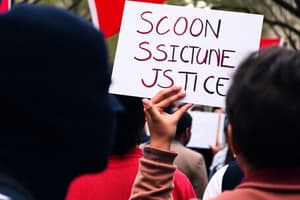Podcast
Questions and Answers
Which of the following can be considered a type of conflict?
Which of the following can be considered a type of conflict?
- Personal conflicts
- Social conflicts
- Global conflicts
- All of the above (correct)
Cultural capital only refers to financial assets a person owns.
Cultural capital only refers to financial assets a person owns.
False (B)
What is denigration?
What is denigration?
The action of unfairly criticizing someone or something.
___ can arise from differing values and beliefs.
___ can arise from differing values and beliefs.
Match the types of conflict with their descriptions:
Match the types of conflict with their descriptions:
Which of the following best describes 'marginalisation'?
Which of the following best describes 'marginalisation'?
Wealthy individuals often face more barriers in accessing education than those in poverty.
Wealthy individuals often face more barriers in accessing education than those in poverty.
What impact do stereotypes have on individuals?
What impact do stereotypes have on individuals?
Equality of opportunity means that everyone should have the same chance to _____ regardless of their background.
Equality of opportunity means that everyone should have the same chance to _____ regardless of their background.
Match the following types of inequality with their examples:
Match the following types of inequality with their examples:
Which of the following is a barrier to equality of opportunity?
Which of the following is a barrier to equality of opportunity?
Equality of opportunity leads to social justice and economic growth.
Equality of opportunity leads to social justice and economic growth.
Name two factors that affect opportunities.
Name two factors that affect opportunities.
Which term best describes the unfair treatment of individuals based on characteristics such as race or gender?
Which term best describes the unfair treatment of individuals based on characteristics such as race or gender?
Inequality only refers to economic disparities among individuals.
Inequality only refers to economic disparities among individuals.
What is the relationship between dominant groups and minority groups in terms of power?
What is the relationship between dominant groups and minority groups in terms of power?
In society, _____ refers to the unequal distribution of resources and opportunities.
In society, _____ refers to the unequal distribution of resources and opportunities.
Match the following terms with their definitions:
Match the following terms with their definitions:
Which of the following is a potential consequence of discrimination?
Which of the following is a potential consequence of discrimination?
Cultural assimilation refers to the process where minority groups adopt the culture of dominant groups.
Cultural assimilation refers to the process where minority groups adopt the culture of dominant groups.
Name one way individuals can advocate for equal rights.
Name one way individuals can advocate for equal rights.
Flashcards
Inequality of Access to Education
Inequality of Access to Education
Some people have limited access to quality education because of factors like their socioeconomic background.
Equality of Opportunity
Equality of Opportunity
Everyone has an equal chance to succeed, regardless of their background.
Impact of wealth and poverty
Impact of wealth and poverty
Wealth or poverty affect access to education, healthcare, and opportunities. Poverty often creates a cycle of disadvantage.
Stereotypes
Stereotypes
Signup and view all the flashcards
Marginalization
Marginalization
Signup and view all the flashcards
Factors affecting opportunities
Factors affecting opportunities
Signup and view all the flashcards
Barriers to equality
Barriers to equality
Signup and view all the flashcards
Equality of opportunity example
Equality of opportunity example
Signup and view all the flashcards
Cultural Capital
Cultural Capital
Signup and view all the flashcards
Conflict (social)
Conflict (social)
Signup and view all the flashcards
Conflict causes
Conflict causes
Signup and view all the flashcards
Personal Conflict
Personal Conflict
Signup and view all the flashcards
Global Conflict
Global Conflict
Signup and view all the flashcards
Discrimination
Discrimination
Signup and view all the flashcards
Dominant Group
Dominant Group
Signup and view all the flashcards
Minority Group
Minority Group
Signup and view all the flashcards
Inequality
Inequality
Signup and view all the flashcards
Social Justice
Social Justice
Signup and view all the flashcards
What are the consequences of discrimination?
What are the consequences of discrimination?
Signup and view all the flashcards
Study Notes
Unit 1: Social Justice - Lesson One
- Discrimination is treating someone unfairly based on characteristics like race, gender, age, or religion.
- Dominant groups often gain power over minority groups through social, economic, and political means.
- Dominant groups may use systemic discrimination, cultural assimilation, or resource control to maintain power.
- Discrimination can lead to feelings of injustice, low self-esteem, and mental health issues.
- Communities affected by discrimination may experience social division and limited opportunities.
- Encouraging empathy and understanding of diverse perspectives can help address injustice.
- Peaceful protests, community organizing, and policy changes can advocate for equal rights.
Unit 1: Social Justice - Lesson Two
- Inequality is the unequal distribution of resources, opportunities, and privileges (social, economic, and educational).
- Inequality can lead to marginalization, stereotypes, and negative outcomes for individuals and society.
- Examples of inequality include unequal access to education, healthcare, food, shelter, and clean water.
- Marginalization refers to the social exclusion and disadvantage experienced by specific groups (racial & ethnic minorities, people with disabilities).
- Stereotyping is making generalizations about people based on characteristics and can reinforce discrimination.
- Wealth and poverty significantly influence opportunities and life outcomes, with wealthy individuals often having greater access to resources. Poverty can lead to limited opportunities.
Unit 1: Social Justice - Lesson Three
- Equality of opportunity ensures everyone has a fair chance of success, regardless of background or inherited advantages.
- Factors impacting opportunities can include race, ethnicity, gender, socioeconomic status, and geographic location.
- Education access, employment opportunities, healthcare availability, and representation in leadership roles are examples of equality of opportunity.
- Systemic discrimination, educational inequalities, and economic inequality can hinder equality of opportunity.
Unit 1: Social Justice - Lesson Four
- Culture encompasses the ideas, customs, and social behaviors of a group.
- Denigration is unfairly criticizing someone or something.
Unit 2: Peace and Conflict - Lesson One
- Conflicts can be personal (family/friends), social (community), or global (nations).
- Causes of conflict include miscommunication, differing values/beliefs, and power struggles.
- Conflict can have various impacts on individuals and communities (displacement, loss of life, psychological trauma, economic hardship, and disruption of community structures).
Unit 2: Peace and Conflict - Lesson Two
- No specific details were given for this lesson.
Unit 3: Sustainable Development - Lesson One
- Endangered species are those at risk of extinction (over 40,000 worldwide).
- Factors contributing to endangerment include habitat loss (due to urbanization and agriculture), climate change, poaching, and illegal wildlife trade.
- Biodiversity is crucial for healthy ecosystems.
- Conservation efforts protect natural habitats, specific species, marine ecosystems, and human impact on wildlife.
Studying That Suits You
Use AI to generate personalized quizzes and flashcards to suit your learning preferences.




